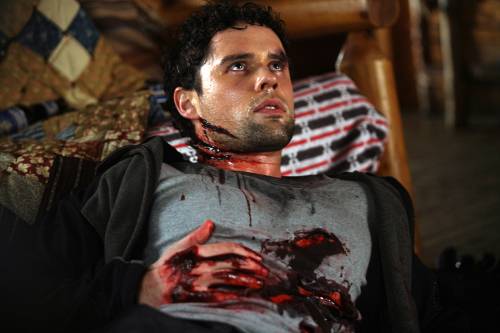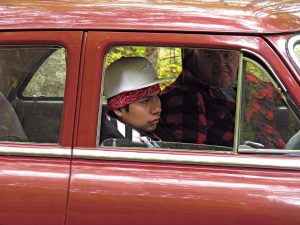REVIEWS: ‘Windigo,’ ‘A Flesh Offering’ & ‘A Windigo Tale’ at imagineNATIVE 2010
FILMS REVIEWED:
Windigo
11 min | 2009 | Canada
Directed by Kris Happyjack-McKenzie
Screens at imagineNATIVE Friday Oct. 22 @ 9 pm,
Al Green Theatre (Bloor at Spadina)
MI Rating: ★★★ (out of 5)
—————— ◊ ——————
A Flesh Offering
95 min | 2010 | Canada
Directed by Jeremy Torrie.
Starring Kaniehtho Horn & Eric Schweig.
Screens at imagineNATIVE Friday Oct. 22 @ 9 pm,
Al Green Theatre (Bloor at Spadina)
MI Rating: ★★ (out of 5)
—————— ◊ ——————
A Windigo Tale
91 min | 2009 | Canada
Directed by Armand Garnet Ruffo.
Starring Gary Farmer, Jani Lauzon & Andrea Menard.
Screens at imagineNATIVE Sunday Oct. 24 @ 7 pm,
Bloor Cinema, 506 Bloor St. W.
MI Rating: ★★★★½ (out of 5)
Night of the Living Wiindigo, or, The (Ab)Original Zombie
If someone described this character to you, what would you think?
[G]aunt to the point of emaciation, its desiccated skin pulled tautly over its bones. With its bones pushing out against its skin, its complexion the ash gray of death, and its eyes pushed back deep into their sockets … like a gaunt skeleton recently disinterred from the grave. What lips it had were tattered and bloody from its constant chewing with jagged teeth. Unclean and suffering from suppurations of the flesh, [it] gave off a strange and eerie odor of decay and decomposition, of death and corruption.
You’d probably think that you were hearing about any of George A. Romero’s Living Dead movies, Max Brooks’ Zombie War novels, or a Left 4 Dead video game.
Gaawin. Nope. That’s a description of the Wiindigo, from Anishinaabe storyteller Basil Johnston’s 1995 book The Manitous: The Spiritual World of the Ojibway.
While Romero, Brooks, and countless others have recently capitalized on the renewed mainstream fascination with zombies, Native communities have been narrating tales of the undead for millennia. Primarily existing in narrative traditions of the Anishinaabeg and the Cree, Wiindigo stories are one of, if not the most, popular traditional narratives out there.
Narratives of Wiindigo vary from community to community, place to place, storyteller to storyteller, and trying to come up with a single description is kind of like trying to come up with one for Naanaboozho: every time you think you’ve got it, another incarnation comes along that blows your definition to smithereens. For instance, in some stories the Wiindigo is a giant hairy monster living in the forest, in others it is a mystical ghost-demon that resides in the water. In still others, it’s both.
Still, there exists many similarities in all of them. Almost always, the Wiindigo begins as a human who is usually starving and, through desperation, tastes human flesh and is infected with an insatiable hunger for more. Changing physically and growing in strength with every meal, the human becomes Wiindigo — a malevolent, immortal, and supernatural hunter holding great power. Part of this is the ability to shape-shift; at times becoming a physical entity that attacks by itself and at others a spiritual entity that possesses human beings to do its bidding.
The most important characteristic of the Wiindigo is it lives off human fear. It emerges from fear, thrives on the fear it produces, and consumes its prey when fear overcomes them. Also important to remember is that, just like fear, Wiindigos can never be ultimately defeated – only staved off, resisted, fought back – until the next time it rears its ugly head. This is perhaps this being’s greatest teaching, in fact, because much truth can be ascertained when we are afraid.
So, considering the popularity of the undead and the obvious political and ideological possibilities these kinds of stories offer, it should come as no surprise that Indigenous filmmakers are turning to the Wiindigo. That trend is particularly evident at this year’s imagineNATIVE, with no fewer than three films telling Wiindigo stories.
The first, simply entitled Windigo, is a short by young Anishinaabe filmmaker Kris Happyjack-McKenzie (playing Friday: see details above). It offers a gritty and mature look at the power of belief. It’s also rather polemic: those who believe in the beauty of the world and inside of themselves overcome evil and survive the threat of the beast in the forest. Those with “weak souls” are caught by it and then consumed, tortured, and forever lost.
Minus some amateurish special effects, this is an impressive first film. With a keen eye for cinematography and directing skills capable of inspiring an understatedly rich performance from a young lead (Ronny Jr. Wabanonik), Happyjack-McKenzie delivers a multifaceted story that deserves attention and accolades.

One wishes for more complexity in Ojibway filmmaker Jeremy Torrie’s A Flesh Offering, an incarnation of the “slasher” genre from a Native perspective (also playing Friday: see details above). Unfortunately, the film starts with possibility, continues stereotypically, and ends predictably. The formula is all there: the irredeemable youth, the ever-watching killer, the grime and the gore, etc. But, besides a Native lead and some beautiful scenery (shot in Quebec), this 85-minute film is much more flesh and too little offering.
It all begins with a Mishum (Eric Schweig) passing on teachings to his granddaughter Jennifer — more like scaring the bejeebus out of her — concerning the evil, truth-telling Wiindigo. Years later, a grown up Jennifer (Kaniehtho Horn) has become a successful artist obsessed with the beast. Along with her attractive friends, the group travels to Mishum’s old cabin in the woods, completely separated from all possible sources of help.
Turns out that each of them has a secret and the Wiindigo is waiting for them. If you’ve seen any slasher film, the rest is rather predictable: they get drunk, have sex, they tell stories by a campfire, all the while acting out their one-dimensionality. The difference here is Jennifer, who endures culturally insensitive comments but seems to like her friends anyways. In fact, for all of her cultural pride, she seems to agree with them, as she is rather dark, sullen, and more interested in how her traditions produce blood and gore than anything else. This, on top of some horrendous scenes of men forcing themselves on hapless women and unbelievably silly dialogue (my favorite is Jennifer’s boyfriend explaining that she is “the most authentic” thing in his life) was enough to make me want the Wiindigo to make MY head explode too (watch the movie to see what I mean).
The issue here is that it’s unknown whether Torrie is trying to be satirical or trying so hard to jam a Wiindigo into the genre that he forgets that the best slasher films don’t take themselves too seriously. If it’s satire, the film certainly veils it well. If it’s a sincere attempt at challenging and/or engaging the genre by introducing and representing traditions of Anishinaabeg storytelling, politics, and aesthetics within it, I gasp at the thought of what A Flesh Offering is actually offering.
This is particularly evident in its ending — which I won’t give away — but in light of this article on the fate of women in slasher films, the final scene makes quite a disturbing statement on endless cycles of violence, the insatiable need for bloody revenge, and the perpetuation of colonialism.

The final incarnation of the Wiindigo to hit the screens at this year’s imagineNATIVE is Ojibwe poet Armand Garnet Ruffo’s A Windigo Tale (screening details above).
In his screenwriting and directorial debut, Ruffo has produced a roller coaster narrative through multiple legacies, including those of residential school abuse, cultural atrophy, and youth gangs, creating a new and chilling incarnation of Windigo that cannot be forgotten.
While narratively uneven in the first half of the film and visually dark in the second, these small issues don’t take away from the power this film holds and the statements it makes about the power of resilience, family, and community in the face of the darkest of forces.
Over two parallel narratives, Uncle Harold (Gary Farmer) explains to Curtis (Elliot Simon) their family’s history, namely, the story of his mother (Andrea Menard) Lily’s return to their community after her removal by government authorities and how she joined with Harold’s mother (Jani Lauzon) and partner (Philip Riccio) to confront the spirit of her stepfather-turned-Windigo.
With so many questions and his own future uncertain, Curtis learns that he is the product of both legacies of violence and the bravery of people standing up to this violence. And, without being preachy, Ruffo presents the realization of choice as the final solution: here, the issue isn’t about defeating spirits like the Wiindigo, but how Wiindigos present us possibilities for dealing with the problems they bring.
Because, after all, we must remember that the Wiindigo is human. The beauty is that we have the power to confront, challenge, resist, and ultimately fight those powers that seek to destroy us — namely, ourselves. With high level performances across the board (with special mention going out to David Gardner as Dr. Shannon), A Windigo Tale is worth multiple viewings for its dialogue and debate — choices unto themselves — and is sure to inspire.


I heard about this story just last week on “LOST TAPES” on Sci Fi channel or Animal planet. I seen show’s about Wendigo on both channels lately. I can’t wait to see this one too, I love all legends. Especially spooky scary one’s!